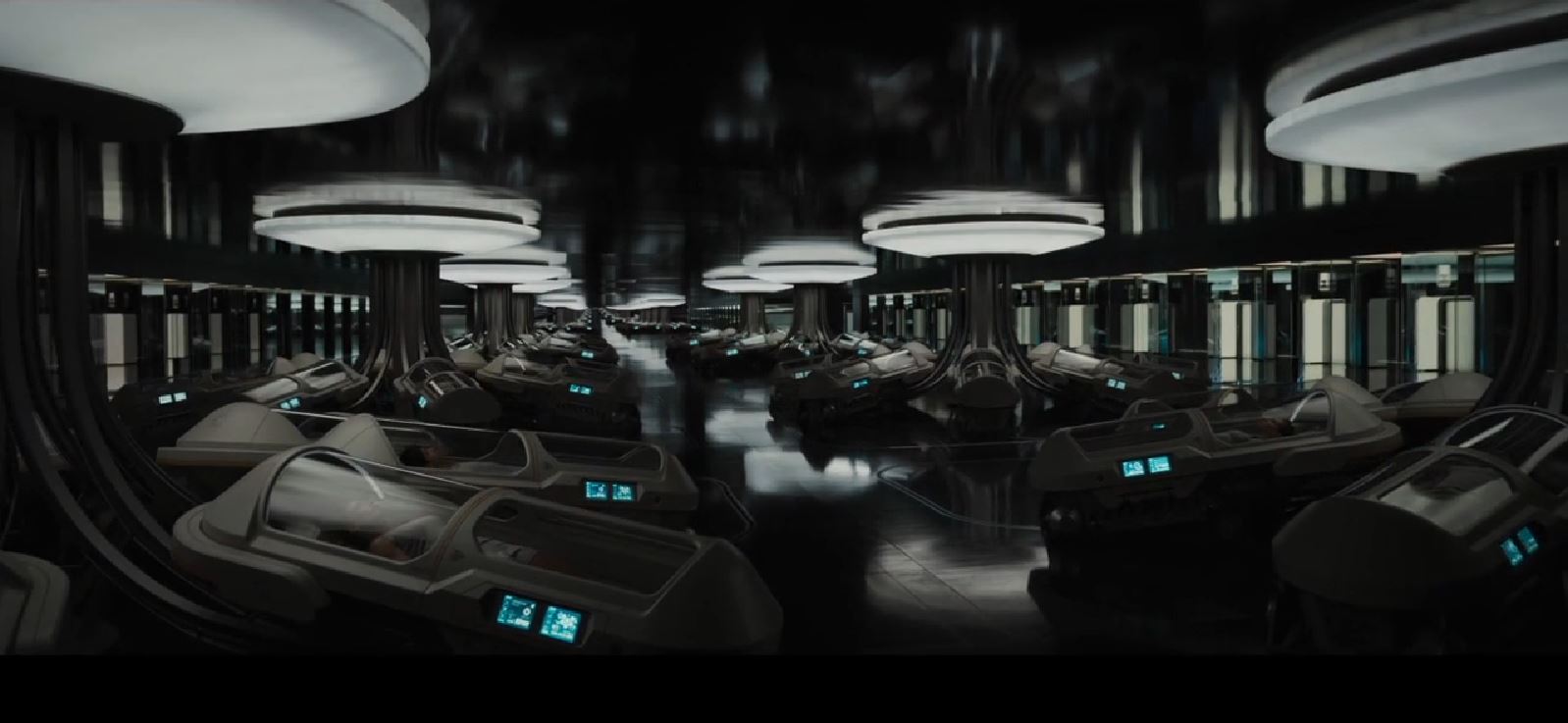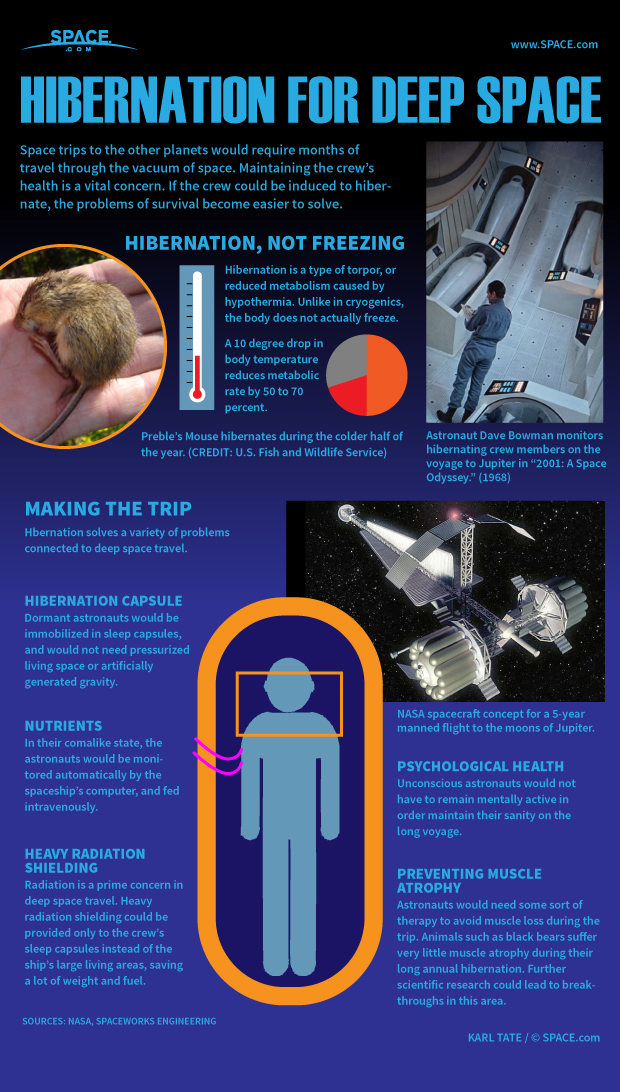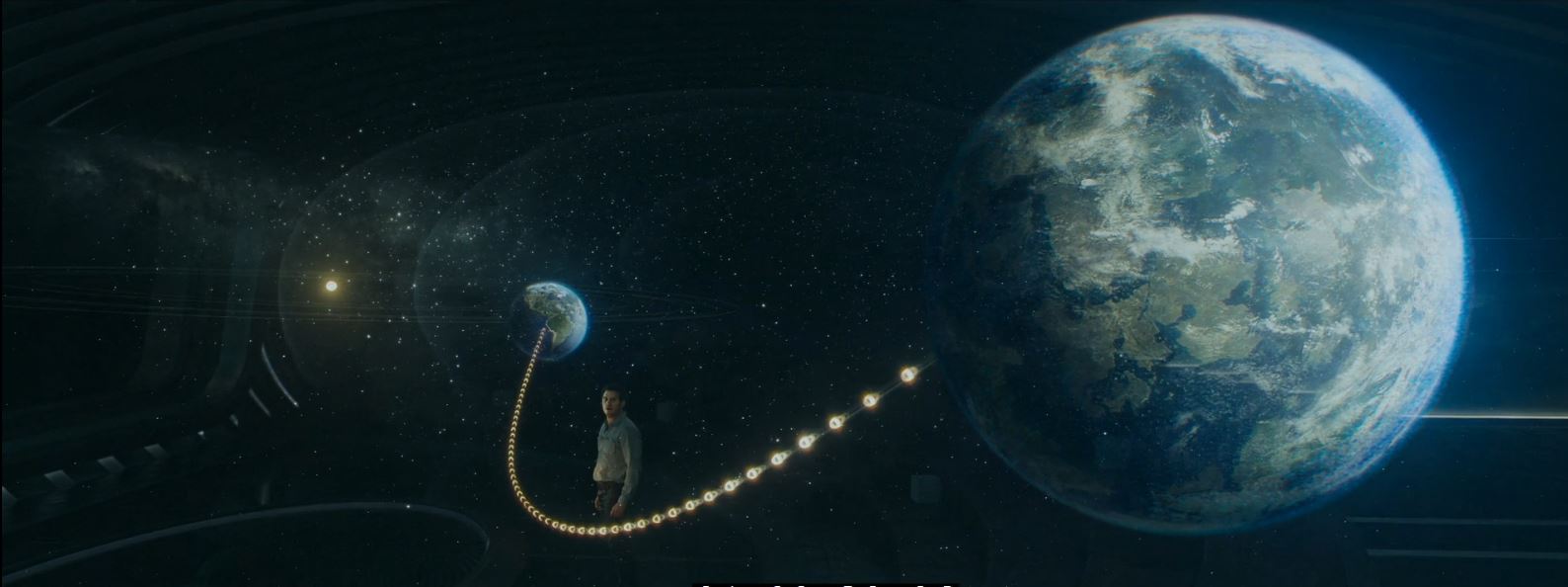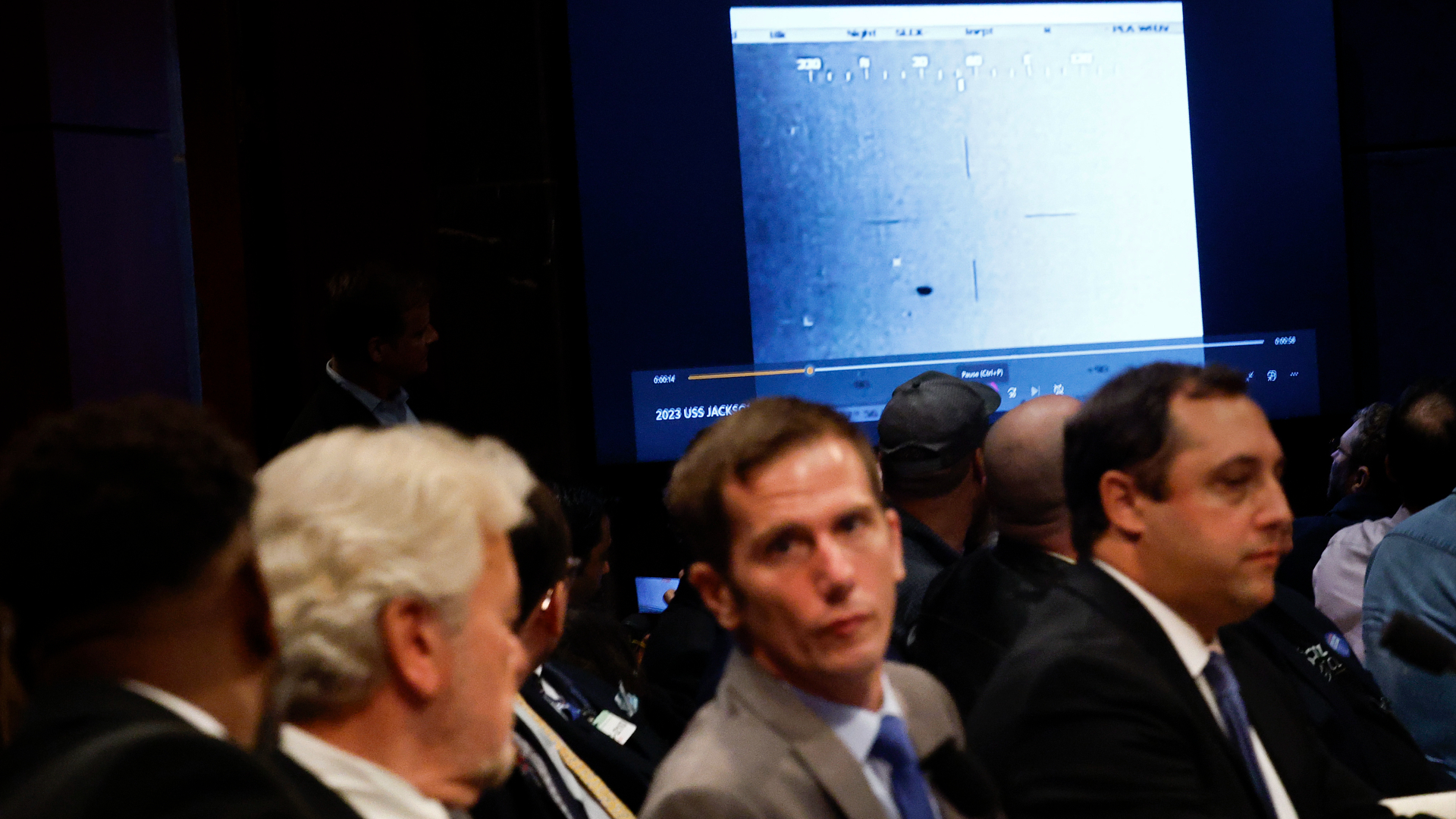Real Science Inspires Voyage to the Stars in 'Passengers'

The new space flick "Passengers" takes place in a far-off, science-fiction future, but modern-day science is laying the groundwork to turn some of those fictional elements into reality.
At a panel discussion Sony Pictures held earlier this month, two real-world scientists talked about two key scientific elements that were portrayed in the film: the search for Earth-like planets around other stars, and placing humans into temporary stasis (a state that's like hibernation) for trips through space.
The scientists were joined by "Passengers" screenwriter John Spaights, who talked about some of the real science that inspired the movie. [Watch the trailer for 'Passengers']

The story of "Passengers" revolves around a spaceship full of more than 5,000 people who are placed in a state of hibernation for the duration of a 120-year-long journey to a distant planet. When two of the passengers wake up 90 years too early, they have to find a way to accept their fate.
John Bradford is an aerospace engineer and COO of SpaceWorks Enterprises, a company that, among other things, received a grant from NASA to investigate a way to place astronauts into stasis (sometimes called a "hypersleep" state) during spaceflight. Bradford explained that NASA might be interested in placing humans into a state of stasis for the six- to 12-month trip to Mars, which would be significantly shorter than the 120-year voyage that's portrayed in the movie.

When in stasis, astronauts wouldn't consume as many resources, which would be a cost-saving measure. And because astronauts in stasis don't need to move around, they might not require such a large transportation vehicle. Remaining in one place could have the further benefit of protecting the astronauts from space radiation, because they could be inside a small compartment with heavy shielding that would protect them against that radiation — which is a major concern for human missions to Mars.
There are existing technologies that Bradford said SpaceWorks is drawing on in its investigation of stasis for astronauts.
Breaking space news, the latest updates on rocket launches, skywatching events and more!
"We leverage heavily on a process called targeted temperature management, or therapeutic hypothermia," he said. "This is done in hospitals currently for cases of cardiac arrest [and] traumatic brain injuries."
The process involves lowering the person's core temperature by about 10 degrees, and essentially giving their body time to recover from a traumatic injury, Bradford said. In that state, the human body's metabolism lowers by "about 70 percent," and consumes less oxygen. Typically, this is done for only a few days, but Bradford said that there are a few cases in which a person has remained in that state for "up to two weeks, and we're trying to extend it out to months," he said. SpaceWorks has not yet entered into human trials of the technology, however.
Bradford noted that "Passengers" added one accurate detail about the state of hibernation, or stasis — when the passengers in the movie wake up from the state, they are extremely tired. Bradford explained that the body doesn't actually "sleep" while it's in stasis — it never enters the REM state that typically defines deep sleep; so when people wake up, they're extremely tired. (He said that animals that hibernate actually wake up from hibernation so they can sleep normally.)
With therapeutic hypothermia, patients often take days to regain their strength and awareness, and that's an issue for astronauts traveling to Mars, since they might have to be awake and alert in a matter of hours.
"If we're looking at a short-stay mission [to Mars], when we maybe only are going to be there for 30 days, you can't spend days or a week or two trying to acclimate yourself and be ready to do work and stuff. So that's definitely an issue," Bradford said. ['Hibernating' Astronauts May Be Key to Mars Colonization]
Medical hypothermia is also not the kind of thing that makes people look their best, and Spaights said that this was one place in the movie where he had to steer away from the real science.
"I looked at a lot of ways of potentially putting people to sleep for space and there, as in many places in sci-fi screenwriting, I ran into tensions between the dramatic requirements of the film and hard science," he said. "Meaning that our best bet for putting people down right now would be either an extreme therapeutic hypothermia or a freezing process coupled with the development of some perfect cell-by-cell antifreeze to prevent ice crystal rupture of tissue. And none of those things are real sexy to wake up from, and none of those are states in which Sleeping Beauty in her bed would look particularly gorgeous. So the hibernation in this movie is a little more magical, just because we needed people to be cute in those pods."
A colony planet
In "Passengers," the central spaceship is headed for a colony planet called Homestead II. Images of the planet show a very Earth-like locale. Spaights said that in his mind, this was a planet that had the right ingredients for life but "the magic never happened," and life didn't actually develop. So, the plan would be to have Homestead II terraformed or seeded with life from Earth, meaning that humans would bring life forms from Earth and let them spread out over the planet, making the biosphere very familiar to visitors from Earth.

Tiffany Kataria, a planetary scientist at NASA's Jet Propulsion Laboratory, specializes in studying the atmospheres of planets around other stars. She spoke about the landscape of potentially habitable planets in the nearby universe.
"We know that basically every star should have an exoplanet around it," Kataria said. "That is regardless of size [or the star] or mass or whatever. When we talk about habitable planets more akin to Earth, that goes way down. It's more like 5 to 20 percent of stars should have a planet like that, if we're thinking about a sun-like star."
Saying that a planet is "akin to Earth" generally means that the planet is rocky (like Earth, Mars and Venus), and that it lies in the so-called "habitable zone" of its parent star, which is a location where the planet's surface temperature could be about right for liquid water to exist there (because liquid water is a prerequisite for every type of life known on Earth). Of course, Venus and Mars have demonstrated to scientists that a planet in or near the habitable zone of its star can still be uninhabitable. The planet's atmosphere might have a runaway greenhouse effect that makes it uninhabitable (like Venus), or that atmosphere might be lost to space (like Mars).
So what are the odds that there is a planet like Homestead II within a reasonable distance of Earth? (The spaceship in the movie travels at 50 percent the speed of light for the better part of 120 years, so the planet would be about 60 light-years away.)
"I think we simply don't know," Kataria said. "The probability is that it must be out there. I think what drives our field forward is thinking about places that we could colonize and move to. There are equations and various theories put forth to postulate how likely [it is that such a planet exists], but fundamentally, it's still pretty open-ended."
Spaights said that he tried to stick to real science when imagining the world of Homestead II and its location relative to Earth.
"I did investigate our general galactic neighborhood. Traveling at a fraction of the speed of light for 120 years can't actually get [a ship] very far; there's really just a basket of stars that they could be going to," Spaights said. "I had a general notion of where they might have found the habitable planet, and maybe stretched a little bit how far they might have gone [to get there]."
He did throw in one real-world detail: The ship does a slingshot maneuver around the star Arcturus, which is located about 37 light-years from Earth. On the other hand, he said he also "took a little bit of liberties" about the view that the passengers would have through the windows of the ship.
When you're looking for planets that might "support life," Kataria said it's also possible that those life forms might be fundamentally different from those we find on Earth.
"I mean, our only example [of a planet that hosts life] is Earth, and so I think fundamentally we really need to expand our own imaginations in terms of thinking about what life really means and how life could really emerge and evolve on other planets," Kataria said.
To date, scientists have identified about 3,000 planets around other stars, Kataria said; the first was identified in 1995, but the majority of them were discovered in the last seven years with the Kepler Space Telescope. Meanwhile, characterizing the features of those distant planets — their size, whether they are gaseous or rocky, their atmospheric composition and whether or not they have liquid oceans — is a task for more advanced telescopes. Two major upcoming telescopes are the Transiting Exoplanet Survey Satellite (TESS) and the James Webb Space Telescope (JWST). TESS will identify more planets around bright stars that will be ideal for follow-up studies that aim to characterize those planets and even search for signs of life there. JWST, though it was not specifically built to study exoplanets, will be equipped to characterize some planets and study their atmospheres.
While there is a long way to go, Kataria focuses on the fact that the study of exoplanets has exploded in recent years.
"I'm sure most of the people in this room remember when there were only nine planets that we knew about," Kataria said. "And so kids these days wake up and think, 'Oh, there are thousands and thousands of planets out there!' That's a crazy thing to grow up with, knowing that there's probably life on these distant worlds."
Follow Calla Cofield @callacofield.Follow us @Spacedotcom, Facebook and Google+. Original article on Space.com.
Join our Space Forums to keep talking space on the latest missions, night sky and more! And if you have a news tip, correction or comment, let us know at: community@space.com.

Calla Cofield joined Space.com's crew in October 2014. She enjoys writing about black holes, exploding stars, ripples in space-time, science in comic books, and all the mysteries of the cosmos. Prior to joining Space.com Calla worked as a freelance writer, with her work appearing in APS News, Symmetry magazine, Scientific American, Nature News, Physics World, and others. From 2010 to 2014 she was a producer for The Physics Central Podcast. Previously, Calla worked at the American Museum of Natural History in New York City (hands down the best office building ever) and SLAC National Accelerator Laboratory in California. Calla studied physics at the University of Massachusetts, Amherst and is originally from Sandy, Utah. In 2018, Calla left Space.com to join NASA's Jet Propulsion Laboratory media team where she oversees astronomy, physics, exoplanets and the Cold Atom Lab mission. She has been underground at three of the largest particle accelerators in the world and would really like to know what the heck dark matter is. Contact Calla via: E-Mail – Twitter
